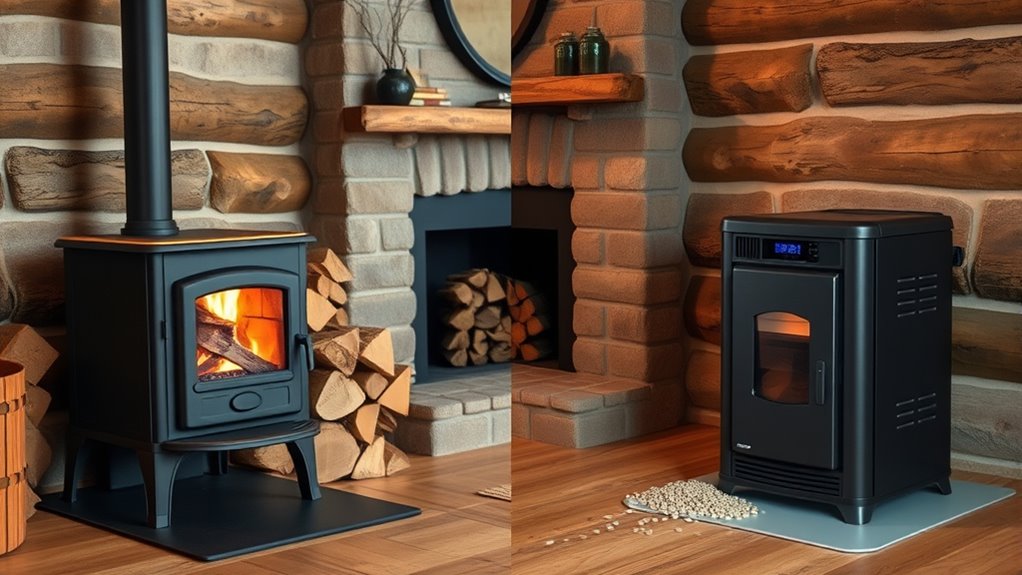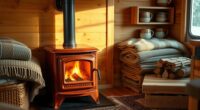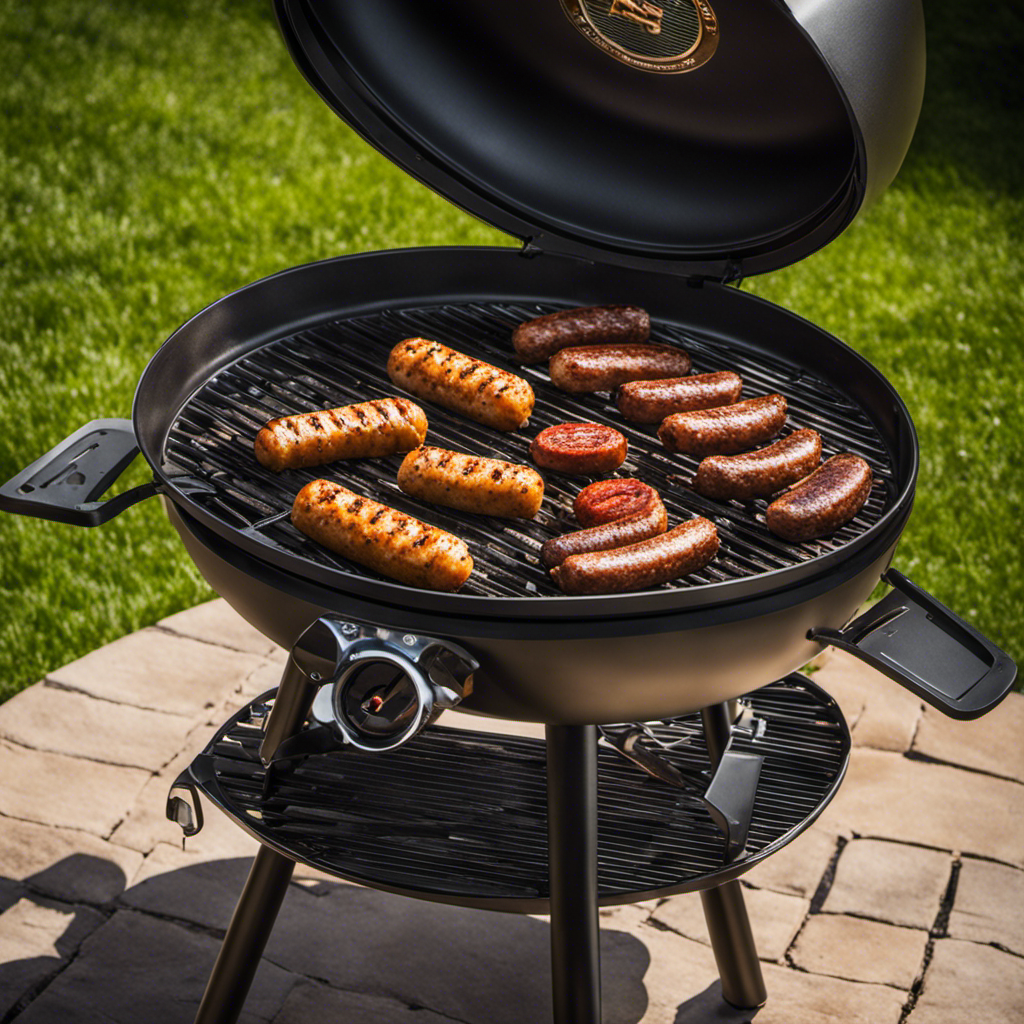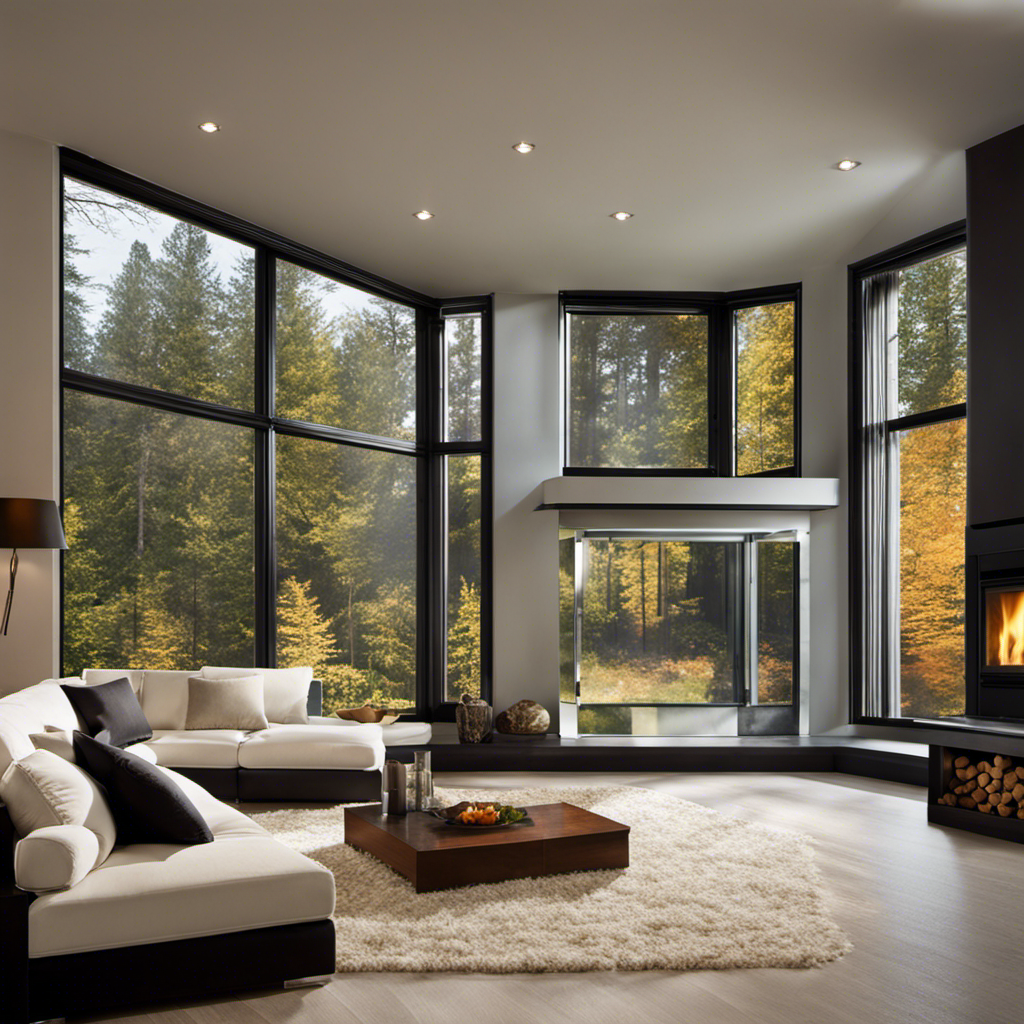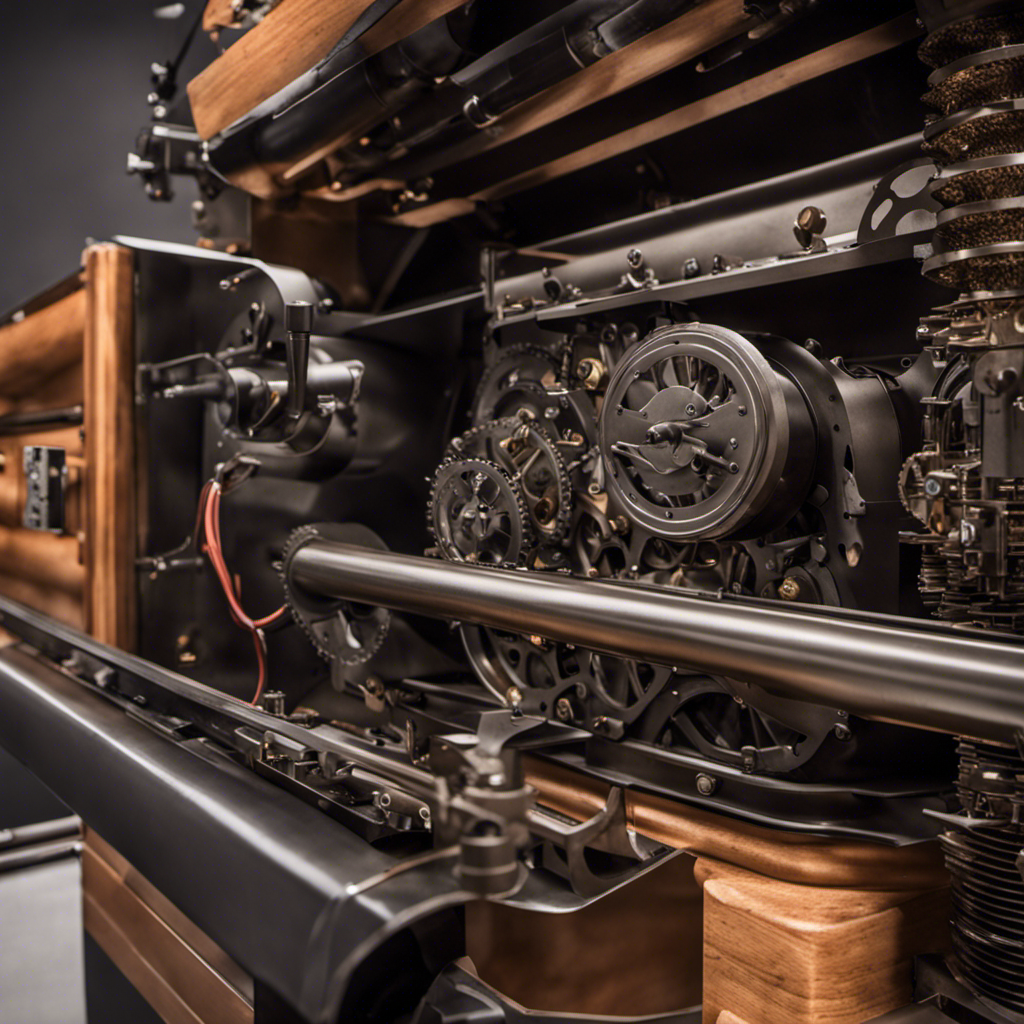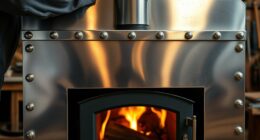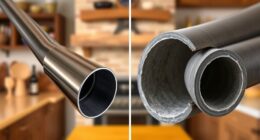Wood stoves offer rustic charm, are generally cheaper upfront, and work well with seasoned logs, but require manual operation and chimney maintenance. Pellet stoves provide automatic fueling, higher efficiency, and cleaner burning, though they cost more initially and need electricity. Both types have pros and cons depending on your space, budget, and lifestyle. To find out which one fits your needs best, explore the differences and features further below.
Key Takeaways
- Wood stoves are generally less expensive upfront but require manual fueling and chimney maintenance, while pellet stoves are more costly but offer automated operation.
- Pellet stoves provide more consistent, even heat and higher efficiency compared to wood stoves, which depend on fuel quality and manual management.
- Wood stoves tend to emit higher particulate matter and pollutants, whereas pellet stoves incorporate emissions control technologies for cleaner operation.
- Proper installation and space are essential for both, with pellet stoves needing electricity and more precise venting; wood stoves require a chimney and clearance.
- Maintenance varies: wood stoves need frequent chimney cleaning and manual ash disposal, while pellet stoves have automatic cleaning cycles and easier fuel handling.
How Wood Stoves Operate

Wood stoves operate by burning logs to generate heat, with the combustion process occurring inside a firebox. Your stove’s chimney design plays a vital role in venting smoke and gases safely outside. Proper airflow is necessary, so you should use effective wood burning techniques—like stacking logs correctly and maintaining dry, seasoned wood—to guarantee an efficient burn. As you light the fire, air flows up through the firebox, fueling the flames, while the chimney draws smoke upward, preventing smoke buildup inside your home. Regularly cleaning the chimney helps maintain ideal airflow and safety. By understanding these aspects, you can maximize heat output, reduce emissions, and enjoy a safe, effective wood-burning experience.
How Pellet Stoves Function

Pellet stoves operate by automatically feeding compressed wood or biomass pellets into a combustion chamber, where they ignite to produce heat. You control the temperature with a thermostat, and the stove adjusts pellet flow accordingly. As the pellets burn, they generate consistent warmth while reducing emissions that impact indoor air quality. You might notice:
Pellet stoves provide consistent, efficient heat with minimal emissions and quiet operation.
- Quiet operation with minimal noise levels
- Steady, even heat distribution
- A small ash pan for easy cleaning
- A digital control panel for precise settings
- A hopper that holds enough pellets for hours of use
Because of their controlled combustion, pellet stoves typically maintain better indoor air quality. Plus, their quiet operation makes them a comfortable heating option without disturbing your environment.
Installation and Space Requirements
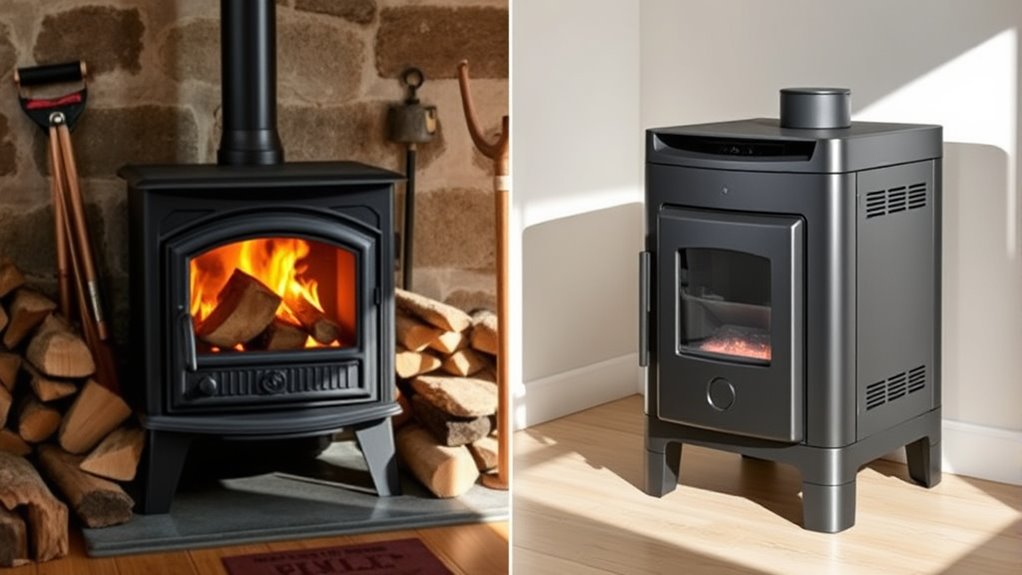
Installing a pellet stove requires careful planning to guarantee it fits comfortably within your available space and meets safety standards. You need to contemplate chimney requirements, as pellet stoves need venting to the outside, which can influence placement. Proper space optimization ensures the stove is accessible for operation and maintenance without cluttering your room. Keep in mind clearance distances from walls and combustible materials to prevent fire hazards. Additionally, verifying that the venting system complies with manufacturer guidelines and local building codes is crucial for safe operation. It is also beneficial to consider the installation location to ensure proper airflow and safety clearance. Ensuring adequate clearance from combustible materials is essential to reduce fire risks and maintain safety standards. Properly planning the installation process can help avoid costly modifications later on.
Cost Considerations

When comparing wood and pellet stoves, your upfront costs and ongoing expenses really matter. You’ll want to contemplate the initial purchase price, as well as how much you’ll spend on operation and maintenance over time. You should also consider the long-term energy efficiency of each stove, as this can significantly impact your overall expenses. Additionally, understanding the cost-effectiveness of different heating methods can help you select the most budget-friendly option for your home. In recent trends, sustainable and eco-friendly options are becoming more popular, which can influence both initial investments and ongoing costs. Evaluating the maintenance requirements of each stove can also play a crucial role in your decision-making process.
Initial Purchase Price
The initial purchase price of wood stoves and pellet stoves varies considerably, making it an important factor to take into account when choosing between the two. Wood stoves often have a lower upfront cost, but you’ll need to think about the type of fuel and brand options available. Pellet stoves tend to be more expensive initially, mainly because of their advanced technology and automation features. Imagine:
- Handcrafted cast iron designs or modern steel finishes
- Compact models fitting into small spaces or large, ornate units
- Fuel types ranging from traditional logs to compressed pellets
- Brands offering different warranties and features
- Installation costs influenced by stove complexity
Your choice depends on initial budget, preferred fuel types, and available brand options, all impacting the overall cost.
Operating and Maintenance
Operating and maintenance costs play a crucial role in the overall expense of wood stoves and pellet stoves. You’ll need to budget for regular cleaning, ash removal, and occasional repairs. Pellet stoves often require less maintenance but need electricity for operation, affecting running costs. Wood stoves offer a traditional fireplace ambiance, but safety precautions like chimney cleaning are essential to prevent fire hazards. Here’s a quick comparison:
| Aspect | Wood Stove | Pellet Stove | Notes |
|---|---|---|---|
| Fuel Cost | Moderate to high | Usually lower | Depends on local fuel prices |
| Maintenance Frequency | Annually for chimney cleaning | Less frequent but needs hopper cleaning | Both need safety checks |
| Ease of Use | Moderate, requires stacking logs | Automatic feeding simplifies use | Affects daily operation |
| Safety Precautions | Chimney inspection, ash disposal | Electrical safety, vent checks | Key for fireplace ambiance and safety |
| Operating Cost | Moderate | Slightly lower | Overall expense varies |
Efficiency and Heating Performance
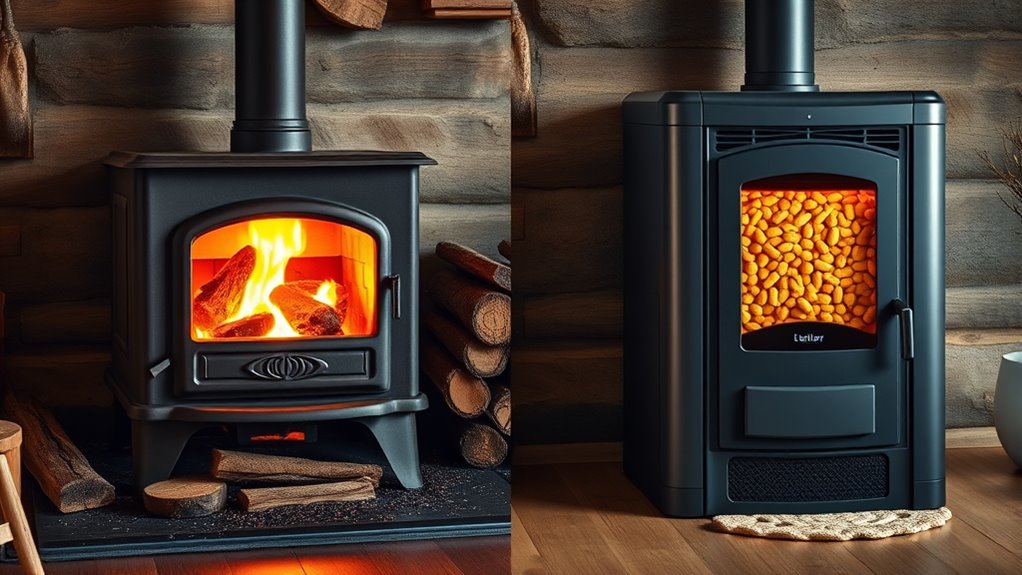
While both wood stoves and pellet stoves are effective heating options, they differ markedly in efficiency and performance. Pellet stoves generally offer higher efficiency due to consistent fuel combustion and advanced thermostat controls, allowing precise temperature regulation. They require minimal fuel storage space, as pellets are compact and stored in hoppers, ensuring a steady heat output. Wood stoves, on the other hand, depend on larger fuel storage areas and need frequent refueling, which can impact overall efficiency. The combustion process in pellet stoves is cleaner and more controlled, resulting in more uniform heat. Additionally, automatic feed systems in pellet stoves contribute to consistent operation and reduced user maintenance. The use of advanced combustion technology in pellet stoves further enhances efficiency and reduces emissions. Incorporating energy-saving features can also optimize performance and minimize fuel consumption. Visualize:
Pellet stoves are more efficient, offering cleaner combustion and precise temperature control than traditional wood stoves.
- Pellets feeding smoothly into a hopper
- Thermostat controls maintaining steady warmth
- Flames flickering evenly in a pellet stove
- A wood stove with a large, open fuel storage
- Consistent heat radiating from a pellet stove
These factors influence how effectively each appliance heats your space.
Environmental Impact and Emissions

When comparing emission levels, pellet stoves generally produce fewer pollutants than traditional wood stoves. You’ll also notice differences in fuel efficiency, which can impact overall emissions and environmental footprint. Modern pollution control technologies further reduce harmful emissions from both stove types, but their effectiveness varies. Additionally, the use of renewable biomass fuels like pellets can lead to a smaller carbon footprint compared to burning untreated wood. Implementing advanced combustion techniques can further improve emission profiles for both types of stoves. Moreover, the weight of wind turbine blades, which varies based on materials and size, influences transportation and installation considerations that can indirectly affect the overall environmental impact of renewable energy equipment.
Furthermore, adopting holistic heating solutions that combine efficient stoves with renewable energy sources can optimize environmental benefits and reduce overall emissions.
Emission Levels Comparison
Although both wood stoves and pellet stoves are popular heating options, they differ considerably in their emission levels and environmental impacts. Pellet stoves generally produce fewer emissions, helping to maintain better indoor air quality and meet stricter emission standards. Wooden stoves, on the other hand, often release higher levels of particulate matter and volatile organic compounds. Imagine:
- Tiny soot particles floating into your living space
- Smoke clouds lingering in the air
- Fine ash settling on surfaces
- Odors from incomplete combustion
- Visible emissions escaping through vents
These differences mean pellet stoves tend to be cleaner and more compliant with modern regulations. Your choice impacts not only the environment but also the air you breathe indoors, making emission levels a key factor in your decision. Additionally, emission levels are influenced by the type of fuel used and the combustion efficiency of each stove. Advances in combustion technology continue to reduce emissions across different stove types, further impacting their environmental footprint. Proper maintenance, such as regular cleaning of ventilation systems, can significantly improve emission performance over time.
Fuel Efficiency Differences
Pellet stoves typically convert fuel into heat more efficiently than wood stoves, leading to less fuel consumption for the same heating output. This higher efficiency means you’ll use less fuel overall, which translates into better energy savings and reduced environmental impact. Because pellet stoves burn compressed pellets with greater precision, they extract more heat from each unit of fuel. In contrast, wood stoves often have more variation in fuel quality and combustion efficiency, resulting in higher fuel consumption. Reduced fuel use not only lowers your heating costs but also decreases the amount of resources needed to produce and transport fuel. Additionally, pellet stoves’ jet propulsion-like combustion process allows for more controlled and cleaner burning. Their wall organization systems can be designed to optimize airflow and combustion efficiency, further enhancing their environmental benefits. Improved combustion technology in pellet stoves ensures more complete fuel burning, reducing emissions and particulate matter. The incorporation of advanced airflow control in pellet stoves enhances their ability to maintain optimal combustion conditions, making them a more sustainable choice for those looking to minimize their environmental footprint.
Pollution Control Technologies
Pollution control technologies play a crucial role in reducing the environmental impact of both wood and pellet stoves. These systems focus on emission reduction and pollution mitigation, making stoves cleaner and safer. Advanced features include catalytic converters that burn off harmful gases, electrostatic precipitators that capture fine particles, and high-tech filters that trap smoke and soot. You might imagine a stove with a built-in scrubber, quietly working to minimize emissions. Some models incorporate oxygen sensors to optimize combustion, further reducing pollutants. Modern designs may also include automated controls that adjust airflow for cleaner burning. Additionally, the integration of regulatory standards ensures that stoves meet environmental requirements and contribute to improved air quality. Incorporating pollution control technologies not only enhances environmental safety but also helps stoves operate more efficiently while meeting environmental standards. By integrating these pollution control technologies, you not only improve air quality but also ensure your stove operates efficiently while meeting environmental standards.
Maintenance and Ease of Use

Maintaining a wood stove or pellet stove requires regular attention to guarantee safe and efficient operation. You’ll need to keep up with fuel storage, ensuring your wood or pellets stay dry and accessible. Proper fuel storage prevents moisture buildup, which can hinder combustion and increase creosote buildup. Cleaning routines are essential; you should regularly remove ash and inspect the stove for soot or creosote buildup, especially around the flue. Pellet stoves often have an automatic cleaning cycle, but manual cleaning of the burn pot and ash drawer is still necessary. Wood stoves may require more frequent manual cleaning and chimney maintenance. Staying on top of these tasks helps prevent blockages, reduces fire hazards, and keeps your stove operating smoothly, making it easier and safer to use.
Aesthetic Appeal and Lifestyle Compatibility
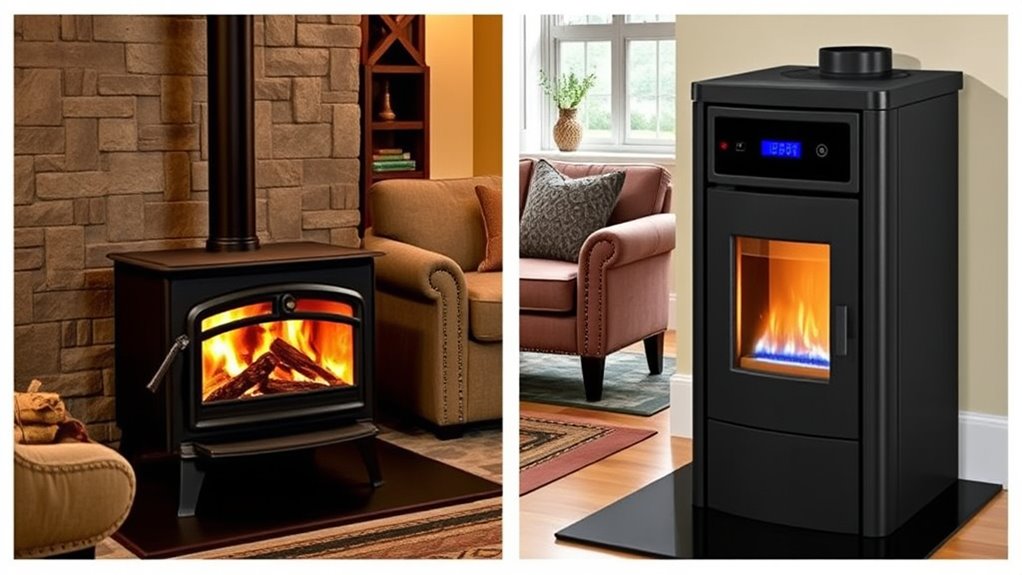
The visual appeal and how well a stove fits into your lifestyle can considerably influence your choice. Your decor style plays a significant role in selecting between a wood stove’s rustic charm or a pellet stove’s modern look. Consider how each stove integrates into your daily routine and home environment.
- A traditional wood stove with a stone or brick surround complements country or rustic decor.
- A sleek pellet stove with glass doors suits contemporary or minimalist styles.
- The stove’s design can serve as a focal point or blend seamlessly into your living space.
- Ease of use impacts lifestyle integration—pellet stoves often feature automated operation.
- Your lifestyle’s priorities, from ambiance to convenience, will guide which aesthetic appeals most.
Frequently Asked Questions
Which Stove Type Has Lower Long-Term Operational Costs?
You’ll likely find that pellet stoves have lower long-term operational costs because of their higher fuel efficiency, meaning you use less fuel over time. Although they may require a higher initial investment, their efficient burning reduces ongoing expenses. Wood stoves might cost less upfront but can have higher fuel costs and less consistent efficiency, making pellet stoves a more economical choice for long-term savings.
Are Pellet Stoves Suitable for Emergency Heating During Power Outages?
Thinking pellet stoves are your emergency hero? Think again. These stoves rely on electricity, making them lousy for power outages. If you want reliable remote heating options during emergencies, look for alternative fuel sources like wood or propane. Pellet stoves shine in efficiency, but they’re not your go-to for blackout scenarios. Keep a backup plan, or you’ll be left in the cold when the power goes out.
Can Wood or Pellet Stoves Be Integrated With Existing Home Heating Systems?
You can integrate wood or pellet stoves with your existing home heating system, but it requires careful planning. You’ll need to take into account ventilation requirements to guarantee safe operation and address installation challenges, like space and venting compatibility. Consulting a professional helps you navigate these factors, making sure the stove works seamlessly with your current setup and maintains your home’s safety and efficiency.
What Safety Features Are Standard in Modern Wood and Pellet Stoves?
Oh, safety features, the unsung heroes of your cozy haven. Modern wood and pellet stoves come equipped with fire safety mechanisms like automatic shut-offs, tempered glass, and smoke detection sensors to keep you safe. These features monitor for dangerous conditions, alert you early, and prevent disasters. So, relax, knowing that your stove is designed with safety in mind, giving you peace of mind and a warm, worry-free home.
How Do Maintenance Routines Differ Between Wood and Pellet Stoves?
You’ll find that maintenance routines differ between wood and pellet stoves. With a wood stove, you need to regularly perform chimney cleaning and ash disposal to prevent creosote buildup and guarantee safety. Pellet stoves require less frequent chimney cleaning, but you still need to manage ash disposal, often more easily due to cleaner combustion. Both demand routine inspections, but pellet stoves tend to be more automated, simplifying upkeep.
Conclusion
Choosing between a wood stove and a pellet stove is like picking the right tool for your home’s warmth. I once met a homeowner who switched to pellets and watched her heating costs drop while enjoying the cozy glow. Whether you want the crackle of wood or the convenience of pellets, understanding their differences helps you make a smart choice. Ultimately, selecting the right stove warms your home and your lifestyle, just like a well-tuned instrument creates perfect harmony.

